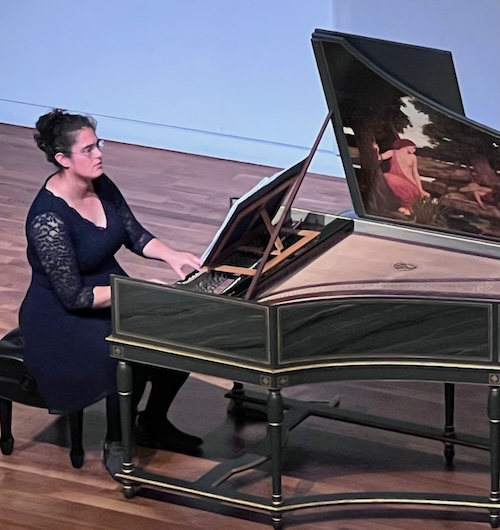Gordis explores academic side of harpsichord in austere recital for Capriccio Baroque

Harpsichordist Lillian Gordis performed Saturday night for Capriccio Baroque. Photo: CB
Lillian Gordis is becoming a Capriccio Baroque fixture. The American-born harpsichordist, who accompanied gambist Jérôme Hantaï last season, returned to Washington Saturday night at Live at 10th and G. This was her second solo recital on the series, postponed from last October. Her two-fold theme highlighted counterpoint and the distant harmonic territories connected by enharmonic spellings, such as the equivalence of A-flat and G-sharp.
The programming combined music of two different periods and regions: late 16th-century England and early 18th-century Germany. John Bull’s Melancholy Pavan and Galliard set the tone of the English half: slow of tempo and in sections over-stuffed with ornate embellishments. Gordis added to the sense of sameness in the music by choosing a fairly limited range of registrations on the German-style harpsichord built by Colin Booth in 2011.
Three selections by William Byrd, in particular, brought out the contrapuntal sensibility of this earlier music: close imitations from hand to hand in the composer’s Fantasia in A Minor, rather than the strict process of fugue. Some of the virtuosic excesses of these demanding pieces challenged the accuracy of Gordis’s hands, with some minor missed key strikes. Byrd’s experiments with metric disjunction came across with impressive rhythmic clarity.
The reason for Gordis’s equal temperament tuning became evident in the last piece before the Bach works, the Hexachord Fantasia by John Bull, built on an ascending and redescending six-note scale.
This ostinato line also transposes through all twelve chromatic keys, not by half-step but in an irregular pattern that cycles through in mostly stepwise motion. On an instrument not tuned to an equal temperament, some of the harmonic shifts can be hair-raising. Gordis smoothed these transitions as much as possible with a fluid sense of rubato in her phrasing. Bull’s score provides a sort of technical amazement rather than melodic enjoyment, but it helped Gordis connect the English music to Bach because of its emphasis on enharmonic shifts.
Gordis focused on pieces from Book II of Bach’s Well-Tempered Clavier, the celebrated collection of preludes and fugues in all major and minor keys, for her first Bach recording in 2022. The four selections from Book II on this recital were different, but perhaps they will be included on her follow-up Bach recording, due out next year.
The Prelude in E Major took time to get going, like a music-box that needed cranking, another sign of the confident rhythmic freedom of Gordis’s approach. Here and in the subsequent Fugue, she emphasized legato, taking the Fugue at a stately tempo, which allowed a clear delineation of the four contrapuntal voices. The Prelude in A-Flat Major came off much the same way, but its accompanying Fugue stood out for its relaxed character. The Fugue’s longer subject balanced with the greater chromatic movement in the countersubject, the whole thing set by Gordis in a higher, more tinkly registration.
Bach set the next Prelude and Fugue in the series in G sharp minor, rather than A-flat major, making it an apt choice for Gordis’s enharmonic theme. Bach noted some echo effects with the markings of piano and forte in this Prelude, which Gordis realized with a rare use of the upper manual. The more active quality of this piece, as well as its gigue-like Fugue, livened up this dour program, made less digestible by Gordis requesting that all applause be held to the end.
The final selection, the Prelude and Fugue in B Major, featured some more two-manual exchanges. The toccata-like Prelude felt slightly dragged out, with the Fugue even more so, as if to bring out its unusual subject, an odd sequence of intervals in half notes.
For her encore, Gordis did something unexpected, described as her first time playing a contemporary work for the harpsichord. She has been teaching this year at Oberlin Conservatory, filling in for Prof. Mark Edwards, who is on sabbatical. One of her students there, Cashel Day-Lewis, composed this lengthy piece, Gruche Who Lust but None Denye, which combined a sense of baroque embellishment and form with polytonal exploration, a boundary-pushing extension of the evening’s theme of enharmonic duality.
French harpsichordist Pierre Hantaï performs two concerts, one featuring music of John Bull and the other J.S. Bach, 8 p.m. May 30 and June 1. capricciobaroque.org


